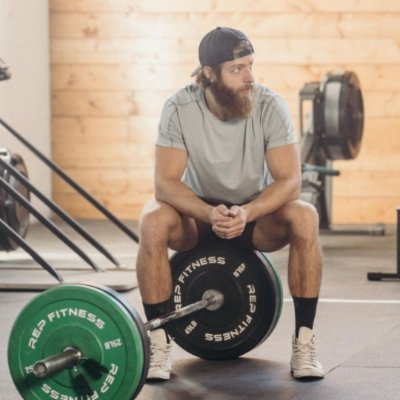The deadlift is an awesome exercise that everyone can benefit from. Much like the squat, the deadlift can have a lot of positive carryover to all walks of life and sports.
I think when most hear “deadlift” their mind instantly goes to the barbell deadlift, however, that’s not the only kind of deadlift that holds a plethora of benefits. You don’t need to necessarily “barbell deadlift” to achieve the benefits below.
In this article, I’m going to discuss seven deadlift benefits that everyone can reap the positives from. Keep in mind, this article is intended to include other deadlift variations outside of the barbell deadlift.
The deadlift is an awesome exercise that every lifter should learn and practice. This exercise can have carryover to daily life, sports, and other exercises in the gym which can make you more dynamic regarding your strength.
Table of Contents+
- What Is a Deadlift?
- Benefit 1: Great for Building Posterior Strength
- Benefit 2: Awesome for Improving Confidence In the Gym
- Benefit 3: Useful for Building Grip Strength
- Benefit 4: Can Help Strengthen the Core
- Benefit 5: Good for Improving Hip Hinge Strength
- Benefit 6: Can Help Improve Power Output
- Benefit 7: Make You More Dynamic In Daily Life
Benefit 1: Great for Building Posterior Strength
The first benefit of deadlifts is that they’re a fantastic exercise for building posterior strength. Posterior muscles include muscles that are located on the back of the body so think glutes, hamstrings, traps, and erectors.
Since you’re lifting weight in front of the body from the ground the posterior muscles will be highly active keeping the bar close to the body and over the midfoot. As you work through different ranges of motion you’ll train different posterior muscles accordingly.
Outside of posterior muscles, you can also get an awesome passive stimulus for anterior muscles as well. For example, off of the floor, you’ll have the quads working to extend the knee and the hamstrings contracting through a lengthened context.
As you lift the barbell, the glutes and erectors will do more work to extend the hips, so essentially, the deadlift can be a great tool for hitting a lot of different muscles while biasing the posterior muscles a little heavier.
There’s a reason lifters and athletes call deadlifts a full-body exercise. If you’re wanting a lot of bang for your buck and target multiple muscles at once then using barbell deadlifts and variations like trap bar deadlifts, Romanian deadlifts, and stiff-leg deadlifts can be great choices.
Benefit 2: Awesome for Improving Confidence In the Gym
Another benefit that’s often overlooked with the deadlift is it can be a fantastic tool for building your confidence and mental tenacity in the gym. The mental benefits of deadlifts take two forms, in my coaching opinion.
The first form is improving confidence in one’s capabilities regarding strength and power output. Everyone can remember their milestone deadlifts, or deadlifts that included a weight that they never imagined possible when they started lifting.
For me, my milestone deadlift was my first 500-lb deadlift back in 2015 in college. Doing this opened the floodgates to understanding what I’m capable of. No matter where you’re at in your lifting journey, deadlifts can be great for improving confidence.
The second form is the skill component of deadlifts. Nothing feels better than hitting a nice clean drive down the fairway with a perfectly executed swing. I think of deadlifts as being similar.
The deadlift is a skill that needs to be practiced often and to build any skill you need to get in reps and practice persistence and dedication. Being able to be consistent and build upon what you’ve learned will have carryover to your other lifts and can even bleed into other life areas.
Benefit 3: Useful for Building Grip Strength
Grip strength is another benefit that you can get from deadlifts. In my coaching opinion, nothing will build your grip faster than pulling heavy deadlifts or doing deadlift variations without straps.
When we talk about grip, there are three grip styles that the hands can perform, crushing, grabbing, and supporting. Deadlifts will train your crushing and supporting strength.
You’ll train your crushing strength when you’re gripping the barbell tight. This entails squeezing something between the fingers, thumbs, and palms.
You’ll also be training your supporting grip strength which is the act of holding onto something for a while, so you won’t only build your ability to squeeze things harder but you’ll also be training yourself to hold onto things longer.
Being good at every grip style, especially crushing and supporting, can have a lot of real-life and sports carryover. Think about how often you need to squeeze or hold onto something to accomplish a task.
Benefit 4: Can Help Strengthen the Core
When we discuss the core, especially in the context of deadlifts, we need to recognize that the “core” is much more than the rectus abdominis AKA the bumpy muscles on the front of our stomach.
The core is a culmination of multiple muscles including the muscles that surround the torso and muscles around the hips. To be honest, different coaches will define training the “core” in different ways as in many occasions the “core” being trained in contextual.
In the context of the deadlift, the core musculature will include muscles like the erectors, obliques, rectus abdominis, and deeper core and back muscles. These are all muscles that need to be strong and rigid when lifting weights from the floor.
More specifically, these muscles need to be producing force to help us maintain the joint angles that we’re after to ensure we’re lifting safely. By performing deadlifts often you’ll be strengthening the muscles that surround your torso and hips.
This will carry over all aspects of life, and sports, and will make you more resilient in all of your active endeavors. Also, this does NOT mean you need to stop training your core directly if you do deadlifts. It simply means that they can be a tool for building the core.
Benefit 5: Good for Improving Hip Hinge Strength
The hip hinge is what I would call a fundamental movement pattern. A hip hinge entails shifting the hips backward in a relatively parallel position and height with the floor while keeping the knees relatively fixed and slightly bent.
The deadlift and its variations can be a great tool for training your hip hinge strength. This can be useful for occasions when you’re bending over to pick things up off of the floor and it can teach you how to lift without displacing a ton of force into the spine.
Improving your hip hinge strength can also have carryover to athletic endeavors as athletic starting positions often entail some degree of hip hinge mechanics. Being able to own that position and move through different degrees of hip flexion can be useful for all types of sports.
To double down on building your hip hinge strength, you’ll want to focus on deadlift variations like the Romanian deadlift that bias and hammer this movement pattern really heavily.
Benefit 6: Can Help Improve Power Output
In the context of beneficial adaptation benefits outside of strength, the deadlift can also be great for improving power output. When we jump and sprint, we need strong glutes and hamstrings to help extend the hips and propel ourselves upward and forward.
Since the deadlift is an exercise that will train a lot of different posterior muscles, it can be a great tool for improving how much “oomph” we can put into hip extension.
For example, if you can deadlift more than your bodyweight then I would argue there’s a good chance your hip extensors will produce more power and force than someone who’s never trained their hip extensors at higher intensities.
Now, obviously, there are a lot of factors at play here and a ton of nuance to that statement above, but the takeaway is that stronger hip extension muscles and a more readily trained nervous system have more power output potential than ones that are non-trained.
Benefit 7: Make You More Dynamic In Daily Life
The final deadlift benefit that I stress to everyone in my life is that deadlifts will make you a lot more dynamic in how you move and navigate the world around you.
Now, this isn’t to say that you’re walking around on your work commute doing movements that replicate a barbell deadlift, but more so, performing deadlifts and deadlift variations can make you stronger in a variety of ways for whatever life throws at you.
Whether you’re helping a friend move, picking up your kids from the ground, or doing yard work, you’ll never regret performing deadlift variations that allow you to strengthen your back, hamstrings, and glutes.
Final Thoughts
There are countless benefits that come along with performing deadlifts. Whether you’re a weathered lifter or you’re just getting into the gym, performing some type of deadlift can benefit you in multiple ways.
This article is not to say you have to barbell deadlift, but instead, performing any form of deadlift and understanding their movement mechanics can be incredibly useful.
If you have benefits that you’ve found with performing deadlifts, drop them in the comments below or reach out via Instagram (@jake_boly or @that_fit_friend)!

















Add a Comment